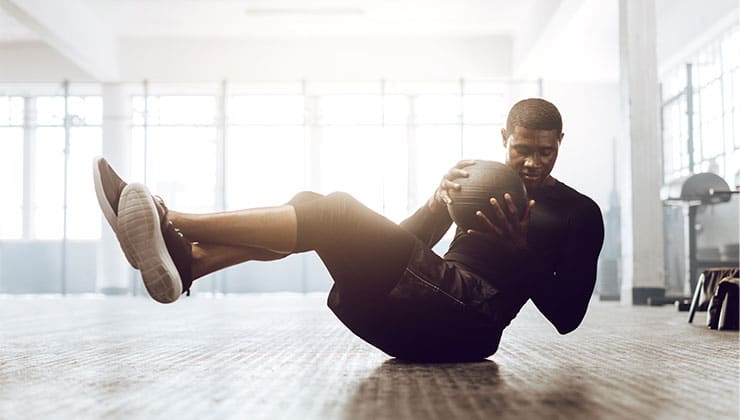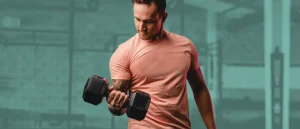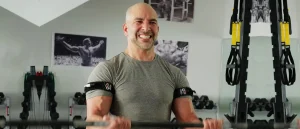Back Pain When Squatting? Fix Your Butt Wink
No, butt wink isn’t the newest way to flirt in the gym (although, we recommend avoiding both). It’s a common mistake to look out for when squatting, which can take away from squat gains, and increase your risk of lower back injury.
Squats are fundamental for building strength and power in your glutes, quads, and core, so getting them right is crucial.
Below, we break down the mechanics of a butt wink, and exactly how to prevent it.
What Is a Butt Wink?
Butt wink occurs when the pelvis tucks under your body at the bottom of a squat, causing your lower back (specifically, the lumbar spine) to round. When your hips scoop under like this, it’s called a posterior pelvic tilt. Because your pelvis and spine are connected, as your pelvis tilts, your spine rounds to accommodate your range of motion.
The Risks of Butt Wink
Squats should be performed with a neutral spine—where the vertebral column is stacked in vertical alignment—not with a posterior pelvic tilt, as seen in the butt wink. You can maintain a neutral spinal position throughout the entire motion of your squat by properly bracing your core to create the pressure needed to stabilize your spine. In this position, the load you’re bearing compresses directly down the spine, where it’s most resilient to injury (1).
When you allow the spine to flex and your hips to tilt under, as with butt wink, the ability to adequately pressurize and stabilize is lost. The load is no longer supported in that strong, straight line. This isn’t a huge issue during bodyweight squats—butt wink isn’t considered good form, but the risk of injury during lighter-load activities is relatively low. When you start stacking up your barbell with plates and clocking in more reps, butt wink results in excessive force on the spine which can lead to disc bulges and other back injuries (2).
Let butt wink go uncorrected and your performance will also take a hit. A strong braced core and neutral spine help you increase your power to push heavy weights.

Want exclusive content? Our digests do that.
The best science-backed, expert-driven health and lifestyle content delivered to your inbox, weekly.
What Causes Butt Wink?
The three most common causes of butt wink (and those within your control) are limited mobility, lack of stability, and incorrect form. The latter is most common among beginners who are still learning to squat properly. Another less common issue is your anatomy. Determining which issue is causing your butt wink is the first step to fixing it.
Incorrect form
Start by ruling out a form problem by practicing proper squatting form. Here’s our checklist to make sure your form is perfect from head to toe. If you can maintain these positions through the full range of motion, you can be pretty sure you’re in a good position. Try it while inspecting and adjusting your form in a mirror.
Squat stance
- Stand with feet hip-width apart and toes pointed forward or slightly out. If you’re having trouble achieving depth without butt wink, try standing with your feet wider, where you’ll generally have more hip mobility.
- Keep your weight evenly distributed from heels to toes. Splay your toes wide, and grip the floor to increase stability.
- Stand with a slight bend in the knees.
- Keep your pelvis upright. Think of it as a bowl you’re trying to not spill forward or back.
- Engage your core by drawing your belly button towards your spine. (Think: ribs down.) It should feel like you’re actively drawing your ribs toward your hips.
Squat movement
- Sit back with your hips and bend your knees, tracking over the toes, while keeping your feet pressed into the floor as if you’re sitting into a chair behind you.
- Lower your hips as deep as your can while keeping your rib cage stacked over your pelvis, and core engaged.
- Push through your feet and glutes to return to standing.
Lack of stability
If your form feels out of your control, you probably need to increase your stability. The good news: it’s an easy fix. By practicing how to engage your core, brace your core during movement, and move through a progression of squat variations you’ll be able to build the strength and ability to squat without butt wink.
Limited mobility
If your form is solid, but you’re still butt-winking you probably have limited mobility in your ankles or hips. To figure out your problem, try the tests below.
Ankle dorsiflexion test
- Get into a half-kneeling position with your front foot directly under your knee and your toes about a hand’s-width away from a wall.
- Bend your front knee forward, trying to touch it to the wall while keeping your entire foot planted on the ground.
- If you’re unable to touch the wall you likely have limited ankle mobility.
Hip flexion test
- Lie on your back with one leg flat on the floor and one knee bent.
- Bring your bent knee to your chest while keeping your other leg on the floor.
- If you can’t move your knee closer than a 90-degree angle with your hip, your mobility is likely limited.
Anatomy
People with deeper hip sockets will naturally have less mobility when it comes to squat depth because the socket acts as a barrier. Once your femur hits this barrier, the pelvis will start to tilt to extend your squat depth, resulting in butt wink. You may be able to increase your range of motion by taking a wider stance and rotating your feet slightly out.
If despite your better judgment you find yourself pushing your limits and butt-winking just to score a deeper squat, check yourself—you’re probably ego lifting. Don’t be afraid to decrease your squat depth to avoid butt wink.
Hone’s testosterone assessment is the simplest way to uncover whether your levels are low. It’s fast, simple, and you can do it from home. And if low T is the problem, Hone can help you get you back on top of your game.
Exercises to Fix Butt Wink
If lack of stability or mobility is your issue, here are the best exercises you can do to fix each.
To build stability
Since stability is essential for maintaining proper squat form, a strong core is key. Build your core strength by practicing engaging it during isometric core exercises (like planks), then level up by maintaining that engagement through dynamic core exercises involving hip flexion and extension (like dead bugs or bird dogs).
Once you’ve built up the core strength to maintain a stable neutral spine during core exercises, work on maintaining it through this progression of squat variations. These increasingly difficult moves will help encourage the neuromuscular connections needed to achieve a perfect squat with each rep. Perfect the progression below and you’re ready to try traditional barbell back squats.
Assisted squat
When working on your form, holding onto a sturdy surface (like the edge of a squat rack) will act as a safety net allowing you to work on squatting with a neutral spine and reaching full squat depth without risk.
How to: While gripping the surface, lower as far down as you can in your squat before you start butt winking, then hold that position for four seconds. Press the floor away from you and squeeze your glutes to stand tall.
Goblet squat to bench
Finding the end range of motion in your squat can be difficult, which is where practicing with a box, bench, or chair comes in handy. Keep your muscles engaged throughout the movement by doing a quick tap-and-go on the edge of the seat rather than fully sitting and losing tension.
How to: Hold a kettlebell or dumbbell in front of your chest. Stand with feet hip-width apart or slightly wider. Sit back with your hips and bend your knees. Tap your glutes on the bench. Press the floor away from you and squeeze your glutes to stand tall.
Goblet squat
Now you’re ready to do a weighted squat without the depth feedback from the bench. By using a goblet position, the weight will act as a counterbalance. Focus on the eccentric phase of your squat by slowing down the lowering portion of the squat to practice your form, and build up strength. Try adding a pulse to practice your control at the bottom of your squat.
How to: Hold a kettlebell or dumbbell in front of your chest. Stand with feet hip-width apart or slightly wider. Sit back with your hips and bend your knees. Press the floor away from you and squeeze your glutes to stand tall.
To increase mobility
If you’re dealing with a mobility issue, improving your range of motion will help stop butt wink in its tracks. Rather than static stretching, active mobility exercises are ideal for building range of motion. They develop stability in the muscles around the joints by contracting a muscle at its end range of motion. Here’s how to increase ankle and hip mobility.
Elevated calf raise
Ankle dorsiflexion—the act of pulling your toes towards your shins—is the specific mobility issue that can limit your range of motion during a squat. Tight calves can often limit ankle dorsiflexion. In addition to stretching your calves with an elevated calf raise, stretch and foam roll the calves to relieve any tightness or knots.
How to: Stand on a step or box with the ball of your foot on the edge and your heel hanging off. Raise up on the ball of your foot into a calf raise. Lower your heel as much as possible at the bottom of the movement to increase ankle dorsiflexion (the exact ankle action needed during a squat).
Quadruped rock back
To open up the hips, try a quadruped rock back which increases mobility in the sagittal plane (forward and back movement) just like during a squat.
How to: Start on all fours with your knees under your hips and your hands under your shoulders. While maintaining a neutral spine, rock your hips forward and back to mimic how you would move when standing upright and squatting. Use your arms to assist you by pushing against the floor. Increase the core engagement by hovering your knees above the floor.
The Bottom Line
Butt wink is a common squat form mistake you should avoid. Unresolved, it can decrease performance and increase your risk of back injury. Most people can fix it by increasing mobility, improving form, and building stability. If you have deep hip sockets, your anatomy may decrease the range of motion available in your squat before butt wink occurs. Rather than pushing through, avoid butt wink by completing shallow, controlled reps.














